Back in January, I presented my six favourite bridges over the Parisian Seine. Then a few weeks ago, we looked at a few of my favourite of Paris’s other bridges – those that don’t cross the river. But we stopped at number 6, saving the best until last. Today, let’s complete the list.
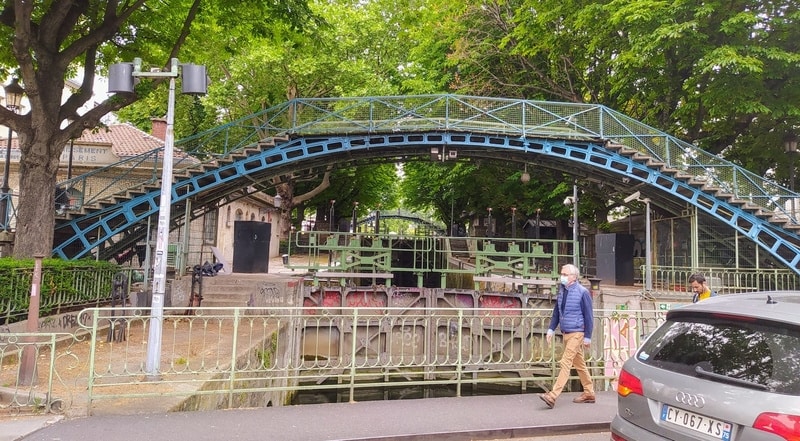
5: Passerelle de la Grange aux Belles
By the beginning of the 19th century, traffic on the Seine had become congested, and there was a shortage of good drinking water in the capital. In 1802, to respond to these problems, First Consul Napoleon Bonaparte ordered the creation of a network of canals serving the city. The Canal de l’Ourcq would bring fresh water from the Ourcq river some 60 km north east of Paris, while between them the Canal Saint-Martin and the Canal Saint-Denis would provide an alternative route for boats travelling through the capital, avoiding a large meander of the river between eastern Paris and the town of Saint-Denis to the north. (Today, the canals are used for pleasure craft; the Canal de l’Ourcq still supplies water, but this is used for street cleaning rather than human consumption).
Of the three canals, one is situated entirely within the city limits: the Canal Saint-Martin. It was completed in 1825 and links the Bassin de la Villette (itself completed in 1808) to the Bassin de l’Arsenal, created on the site of an arsenal serving the Bastille fort, famously destroyed in 1789.
By the second half of the 19th century, the area around the Canal Saint-Martin was becoming densely urbanised. Part of the canal was buried underground in 1862, while along the rest of its route, new bridges were built to connect the surrounding neighbourhoods. Today, the canal is crossed by two fixed road bridges, two swing bridges and six footbridges. The footbridges allow pedestrians to cross even when the swing bridges are open, by climbing and then descending steep flights of stairs.
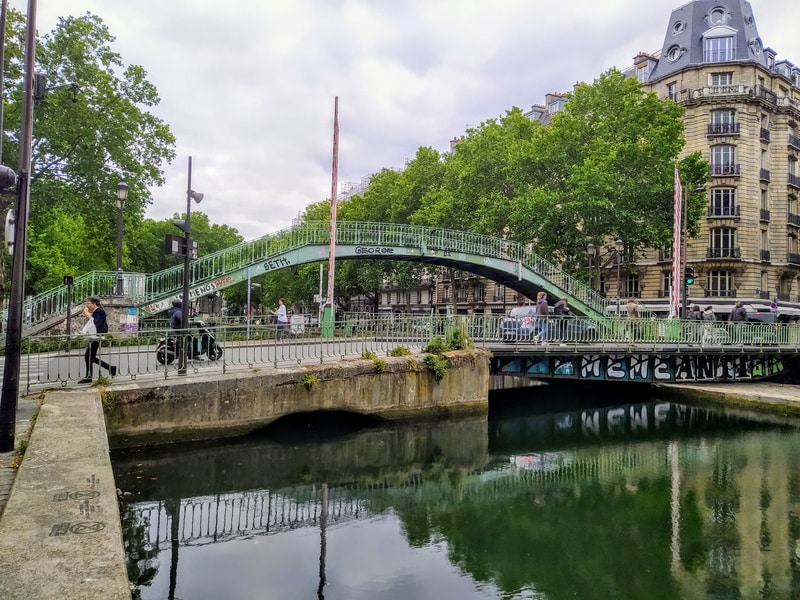
Several of the footbridges, installed around 1860, are built in the same style: arches of cast iron, finished in blue. I could have chosen any of the Passerelle des Écluses de la Villette, the Passerelle des Douanes and the Passerelle de la Grange-aux-Belles to make the top five of this list, since they are virtually indistinguishable. But I chose the Passerelle de la Grange-aux-Belles, as it’s the only one from which you can look directly over both a swing bridge and one of the canal’s four double locks.
The Canal Saint-Martin is in an exciting period of transition right now. One of newly reelected mayor Anne Hidalgo’s last promises before last month’s election was to pedestrianise the roads which line the canal on either side, and this process has already begun. The tow paths were already popular spots for dog walking, picnics and evening drinks, and now this activity can be expanded into the roads. Like the pedestrianisation of the Voie Georges-Pompidou along the Seine, this is proving controversial. Here’s hoping that in time it will be embraced by all sides, as ultimately happened with the riverbanks.
4: Passerelle des Ardennes
The Petite Ceinture, a disused railway in a loop around Paris, has already featured in this list with its bridge over the Cours de Vincennes. Now it features again, this time in a bridge that has found new purpose as a footbridge: the Passerelle des Ardennes, which crosses the Canal de l’Ourcq in the 19th arrondissement. An iron truss bridge, it was built in 1892 to replace an earlier version which had stood since 1852. The current bridge bears the nickname Pont Craqueur – “creaky bridge” – because of the noises it made when trains crossed it. Today, it serves the dual function of bearing testimony to the history of the Petite Ceinture and helping pedestrians cross from the Quai de la Marne to the Quai de l’Oise.

3: Buttes-Chaumont suspension bridge
If you’re looking for nice bridges, you could do worse than spending time in some of Paris’s parks. Don’t look to the formal French-style gardens like the Jardin des Tuileries and the Jardin du Luxembourg. Instead, check out the English-style parks, where the landscaping attempts to recreate natural vistas. The charming Parc Monceau features a stream, which is crossed by a bridge modelled on Venice’s Rialto bridge. The vast Bois de Vincennes, created in the 1850s and annexed to Paris in 1929, is home to a lake with two islands connected to each other and to the mainland by suspension bridges. Some of Paris’s newer parks play host to bridges too. A wood-and-metal bridge, arched in shape but supported by cables, connects two sections of the Promenade Plantée over the Jardin de Reuilly. In the nearby Parc de Bercy, two metal arch bridges connect different parts of the park over the rue Joseph Kessel.
But the best park for bridges is surely the Buttes-Chaumont, one of Paris’s gems. This park on multiple levels is popular with both locals and tourists for its ornate, naturally-inspired landscaping and its views over the city. It features a cave with an impressive waterfall, a lake fed by two streams from the Bassin de la Villette, and a towering island with a folly inspired by a Roman temple.
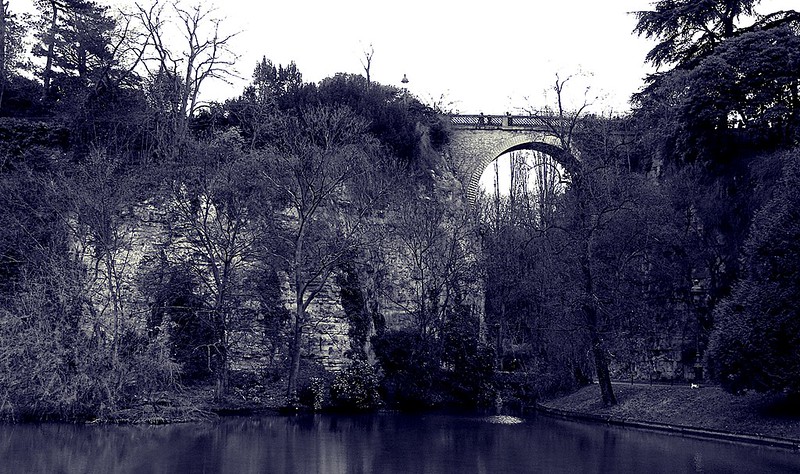
It’s this island, known as the Île du Belvédère, which gives us two more spectacular bridges. On the west side, high above the water, is the inauspiciously-named Pont des Suicidés, which you don’t need me to translate for you. This stone arch bridge is secured now, but was once known for the number of tragic deaths from people jumping from its 22 m-high deck. This morbid phenomenon appears to have reached its peak in June 1896, when 29 unfortunate souls met their deaths this way in just one month.
Perhaps the highlight of the exceptional Parc des Buttes Chaumont is the other bridge, a suspension bridge designed by Gustave Eiffel (yes, that one) and erected in 1867. Lower than the Pont des Suicidés, passing only 8 m above the lake, this bridge is significantly longer, at 65 m, which it achieves in a single span. While this might seem insignificant compared to many of today’s Parisian bridges – the Viaduc d’Austerlitz traverses 140 m, while the Passerelle Simone-de-Beauvoir spans 190 m – it was an impressive feat for its time. The Seine was crossed by several suspension bridges in the early 19th century, but none of these lasted. Besides them, of the bridges over the Seine, only the Pont d’Arcole, a then-recently constructed iron arch bridge with a span of 80 m, surpassed Eiffel’s footbridge. And the Buttes Chaumont bridge’s slender deck makes it look all the longer. It’s a truly wonderful piece of both engineering and art, in a fantastic setting. And, unlike most of Paris’s bridges, it can be enjoyed in relatively clean air, set as it is away from roads in one of the city’s largest parks.
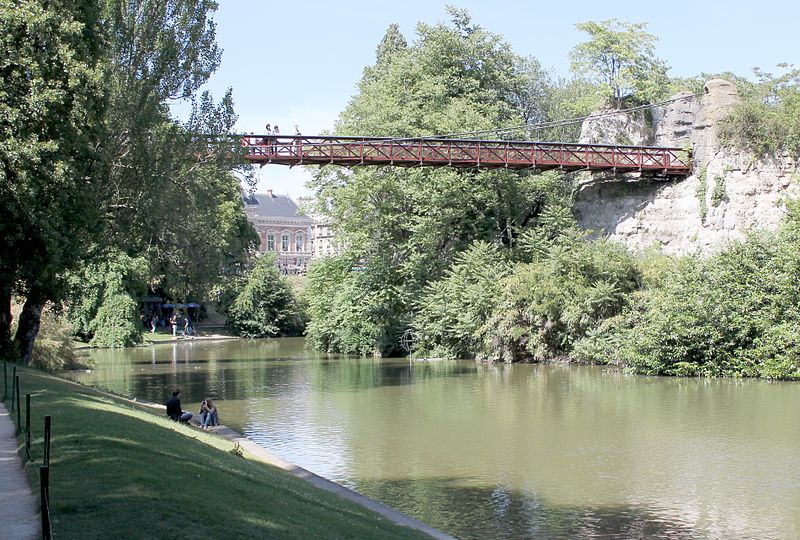
2: Rue de Crimée Lift Bridge
In second place is Paris’s only lift bridge. Before flowing into the Bassin de la Villette, the Canal de l’Ourcq passes under the rue de Crimée, the longest street in the 19th arrondissement. The first bridge here was made of wood, but in 1874, after a fire during the Paris Commune, a metal swing bridge was installed. That bridge wouldn’t last long, due to two major problems.
Firstly, it took 15 minutes to let one boat through; it could take a full hour if multiple boats were moving through together. Given that the bridge was opened around 25 times a day, this caused significant inconvenience for traffic crossing the canal.

Secondly, in the late 1870s the Seine was deepened downstream of the Marne, and it was decided that the Canal Saint-Denis and the Bassin de la Villette should increase to the same depth (3.2 m, from a previous depth of 2 m). Since this section of the Canal de l’Ourcq links the Canal Saint-Denis and the basin, the canal at this point also needed to be deepened, as well as being widened from 11 to 15 m. A wider channel would no longer leave room for a swing bridge, while a bascule bridge of this size would have required significant underground structures, which was impossible at this site.
The only viable option was to build a vertical lift bridge. This would be the second such bridge in Paris, the third in the country and the first to be raised and lowered hydraulically. A beautiful specimen, constructed of steel, the Rue de Crimée lift bridge is still operated around 25 times daily, a process that can be watched from an adjacent footbridge. The bridge is counterbalanced by four weights underground, each attached to a pulley whose wheels turn during operation. For over a century after its construction, each action of the bridge required 2000 litres of fresh water; this was remedied in 2011, when a refurbishment replaced the system with a more modern hydraulics system.

Though it was only the second lift bridge in Paris, it’s the only one still standing. It’s been listed as a monument historique since 1993.
Honourable mentions
Before we get to number 1, let’s spare a moment for the best of the rest:
Bridges of Sighs
Venice’s famous Bridge of Sighs is a covered walkway linking the upper floors of two buildings on opposite sides of a canal. Elsewhere in the world, for instance in the English university cities of Oxford and Cambridge, other bridges have been given the same nickname, since each also connects the upper floors of two buildings, albeit over a road rather than a canal. For its part, Paris counts a number of what I like to call bridges of sighs.
The flagship department stores of the Boulevard Haussmann count three, each on two levels: one connecting the menswear section to the main building of the Galeries Lafayette, and two linking the three buildings of neighbouring Printemps. Over the river, just downstream from the Eiffel Tower, the modern, glass buildings of the Beaugrenelle shopping centre (completed in 2013) are connected by a stylish walkway.
But my personal favourite is the crossing over the rue Sainte-Cécile, a quiet street in the 9th arrondissement near the Grands Boulevards. With an understated elegance it links two handsome office buildings belonging to banking group BNP Paribas.

Roads crossing roads
Most of the bridges that have made this list have either involved rail or water. But in the hillier parts of Paris there are a number of places where roads pass over other roads. In the 8th arrondissement, the rue du Rocher crosses the rue de Madrid on a metal truss bridge constructed in 1868. In the 20th arrondissement, a stone arch bridge dating from 1900 carries the rue Charles-Renouvier over the rue des Pyrénees.
Another bridge, a masonry arch carrying the rue de Tolbiac over the rue du Chevaleret, is the last vestige of an impressive viaduct that, had it not been dismantled in 1996, might very well have made this list. The Viaduc de Tolbiac carried the road over the rail tracks of the 13th arrondissement on their way to the Gare d’Austerlitz, but in the Paris Rive Gauche development project, these were largely buried under a concrete platform, with new buildings constructed above, including housing, offices, commercial space and the famous Bibliothèque François-Mitterrand, the main site of France’s national library.
And now, the moment we’ve all been waiting for…
1: Pont Masséna
Around half of all the bridges in Paris either carry or cross the Boulevard périphérique, the four-lane motorway that encircles the city. Most of these – including the two that cross the Seine, imaginatively named the Pont Amont (Upstream Bridge) and Pont Aval (Downstream Bridge) – are utilitarian concrete structures with no discerning features to put them on this list. But one, which crosses the railway lines of the 13th arrondissement, is unique and impressive enough to warrant first place.
Driving on the périphérique is rarely an enjoyable experience: the average speed is only 38.9 km/h, and in this stop-start environment drivers have to contend with constant lane changes, weaving motorcycles and frequent accidents, all the while breathing some of Paris’s most polluted air. But in the right conditions, the southeastern portion of the road, between the Porte de Charenton and the Porte d’Ivry, can be a somewhat pleasant drive, with views over the railway tracks leading to the Gare de Lyon and the Gare d’Austerlitz, as well as views over the Seine. In particular, while crossing the railway tracks of the left bank, in the 13th arrondissement, the older industrial buildings in sight are joined by some of Paris’s newest, most modern constructions.
The bridge which affords these vistas is the Pont Masséna. Named after an adjacent boulevard, this bridge of steel was completed in 1970. It’s a cable-stayed bridge, with 4 cables supporting the deck from each of two masts 35 m high. It’s 492 m long, with a central span of 161.5 m, making it the city’s longest bridge. The supporting towers make it more of a landmark than the périph’s other bridges, but it’s still often overlooked in favour of bridges that cross the Seine. While it may not have the charm of the Pont des Arts or the grandeur of the Pont Alexandre III, I think it has a certain understated beauty; while it might not look over the Île de la Cité or the Invalides, I think the mixture of industrial and 21st-century architecture is a wonderful sight to behold.
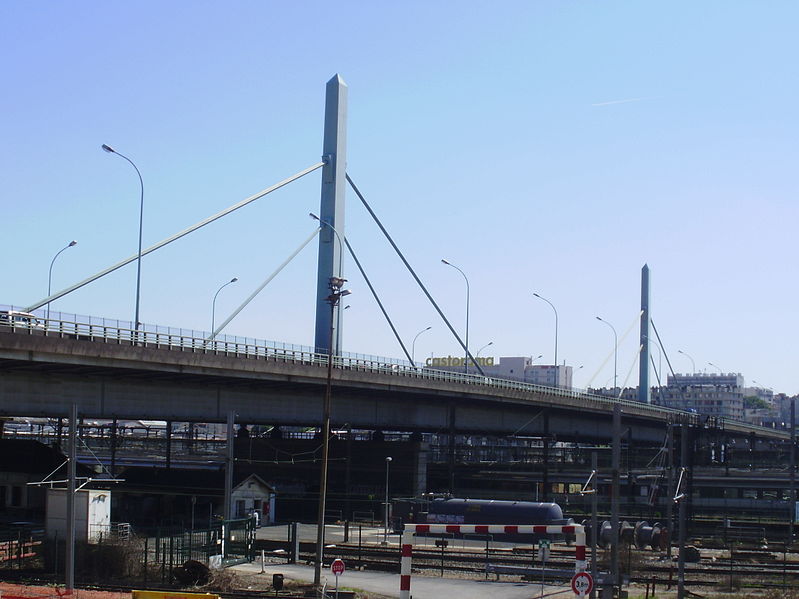
This urban motorway is likely to see major changes in the next decade. Mayor Hidalgo and her green coalition partners want to transition the Boulevard périphérique into a more typical urban boulevard by 2030, with traffic lights and pedestrian access as well as a lot more trees. I’m looking forward to being able to enjoy this bridge without the stress of driving it, with time to take in the sights and without having to focus on keeping myself, my passengers and other road users alive.
I hope you’ve enjoyed reading this list. Think my opinions are a load of balderdash? Get in touch to let me know what your favourite Parisian bridges are! And if you want to find out more about the urban infrastructure of the most beautiful city in the world, sign up below to email updates so you won’t miss out.
 Fabric of Paris
Fabric of Paris